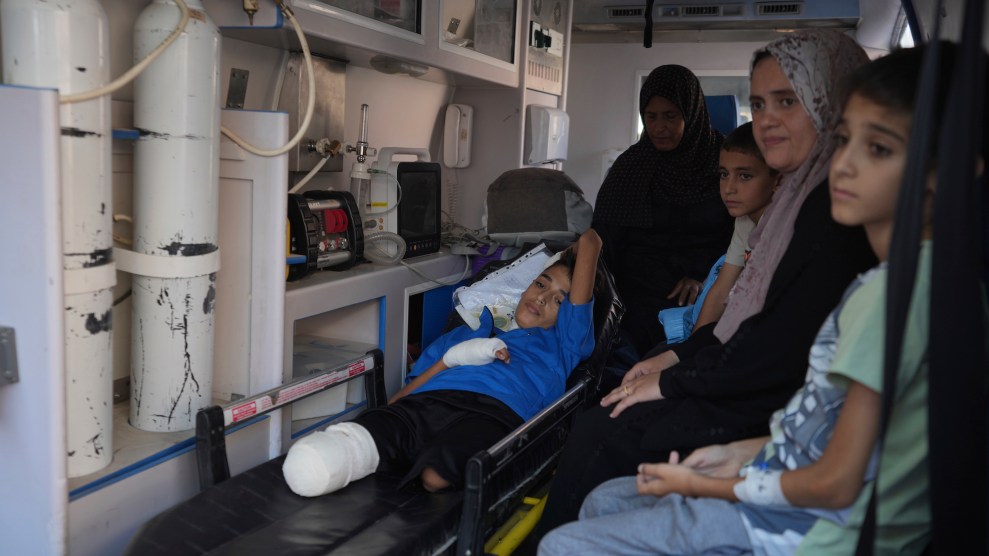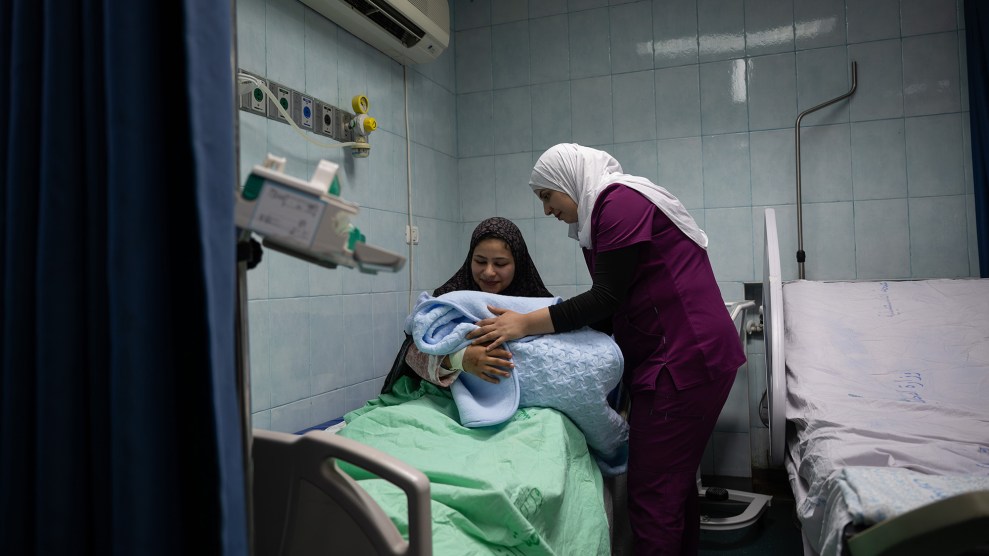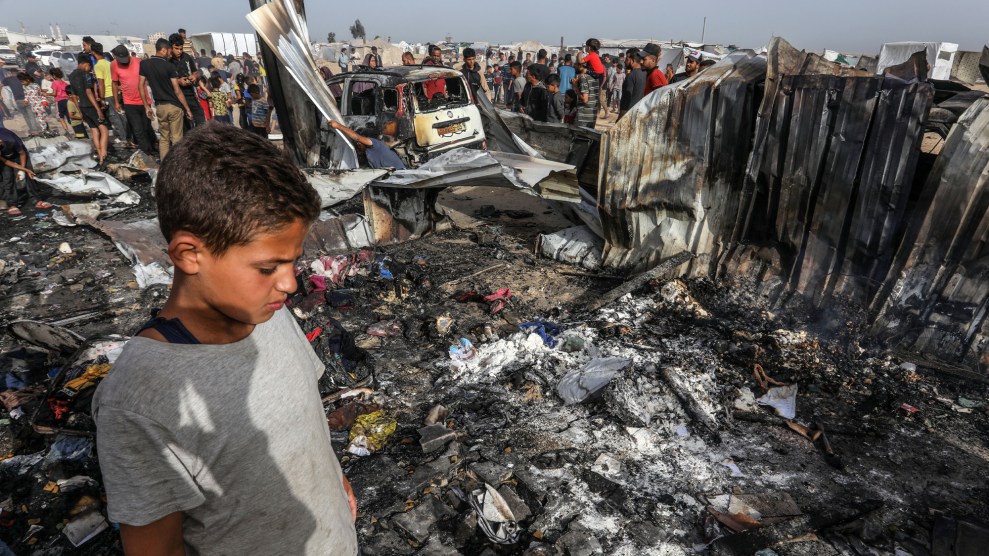
Abdel Kareem Hana/AP
Last December, UNICEF reported that two and a half months into Israel’s offensive in Gaza, at least a thousand children lost one or both of their legs. As more Palestinians become disabled, their risks expand. A United Nations committee warned in May of “the disproportionate impacts on people with disabilities due to the destruction of hospitals, the cut-off of essential services, restrictions, [and] non-existing access to humanitarian assistance” amid the war waged in response to Hamas’s attack on October 7th.
One organization that is trying to help disabled Palestinians in Gaza is Humanity & Inclusion, an international Nobel Peace Prize-winning humanitarian group, which has operated in Palestine—both in Gaza and the West Bank—for nearly three decades. Since October, H&I has provided mobility devices to newly disabled Palestinians.
Their work has been treacherous—multiple H&I staff members have been killed and their office in Gaza City has been destroyed. In mid-June, H&I says the Israeli Defense Forces bulldozed their warehouse in Rafah, where medical supplies and mattresses had previously been stored. (In response to a request for comment on the destruction of H&I’s warehouse, a spokesperson for the Israeli Defense Forces did not deny the warehouse’s destruction, but said the IDF “follows international law.”) The Israeli army has also prohibited many medical devices from entering Gaza, claiming that these are “dual-use items”—that crutches or hearing aid batteries, for example, could have a military use.
Mother Jones spoke to Noor Bimbashi, an advocacy officer for Humanity & Inclusion based in the West Bank about the challenges that disabled people in Gaza face, the impact of aid restrictions, and how those in the West Bank experience violence, too.
This interview has been edited for length and clarity.
The number of amputees, including children who lost limbs in Israel’s offensive, has risen in Gaza since October. How has this changed the type of work that Humanity & Inclusion does?
Back in 2022, the number of amputees was already high. At least 21 percent of households in Gaza had [a person with a] disability. We keep trying to compare this number with what’s happening right now.
The impeded access into Gaza is affecting our rehabilitation services. In order to sustain the well-being of amputees and persons with disabilities, we need more resources. And the shortage of electricity and fuel is impacting our operations.
One of the challenges I’ve heard from my colleagues recently is the fact that after the Rafah offensive our employees became scattered in different areas across the Gaza strip. Sometimes communication is difficult. The number of persons with disabilities, and how many families are in need of rehabilitation—or in need of assistive technologies like wheelchairs or crutches—is increasing by the day, and sometimes it’s difficult to keep up. But we’re trying our utmost best.
In mid-June, H&I said the Israeli army destroyed a warehouse your organization had previously used in Rafah. How has the lack of viable warehouse space affected the services you have been able to provide?
The offensive has forced us to suspend all activities for persons with disabilities across the whole governorate of Rafah. The loss of this warehouse made it impossible for us to stock items in Rafah, in the short term. And even after the end of the offensive, it’s going to take us a lot of time, which, of course, slows down our future assistance to persons with disabilities, especially in Rafah.
In Gaza, even mild injuries are turning into permanent disabilities. “We’re hearing about people having their legs or arms amputated without anesthesia,” says an advocacy officer.
Even our warehouses in other areas sometimes it’s too difficult to reach them, or to find a proper warehouse, since more than 60 percent of buildings are destroyed in Gaza.
Palestine has high rates of disability, including child amputees. Have you all been able to meet that demand of treating kids who are newly disabled? What obstacles stand in the way of getting these kids care?
The nurses that we work with tell us how challenging it is, since they don’t have access to basic tools to treat patients. One of the nurses told me one of the biggest challenges is inability to follow up with patients because of displacement. One day they’re treating a person with a disability, and the next day they can’t find him or her, because they were ordered to evacuate to another place.
The overcrowding in shelters hinders the execution of some of the rehab sessions. But I think the biggest challenge right now is displacement and scarcity of resources.
In Gaza, persons with disabilities have lost all chances for education, or for mental support. They’re the last ones to evacuate because some of them don’t even know that they have to evacuate, like those with hearing difficulties.
We keep calling for Israel to allow us to import some of the tools and resources that are considered “dual use,” but they’re not. So sometimes it’s difficult even to bring into Gaza wheelchairs, crutches, and hearing aids, because some of them are put on the dual use list. The problem is that we’re not even getting the list, so we don’t even know.
There need to be thousands more prosthetics in Gaza. How does delaying getting an amputee a prosthesis negatively impact their quality of life?
First, it affects their mental health. We’ve heard about confusion, anger management issues, because they’re unable to get the right treatment. And even mild injuries are turning into permanent disabilities. The situation in the hospitals is very bad. We’re hearing about people having their legs or arms amputated without anesthesia. It’s devastating. We try our best to find alternatives, but I don’t know what else can be done.
Some children think that their legs might grow again. This is one of the saddest things that we hear on a regular basis, when talking to children. They tell us, we’re waiting for our legs to grow again. Sometimes, it’s difficult to explain that that’s not going to happen.
That’s heartbreaking. How has the team in the West Bank, where you’re based, been supporting H&I members in Gaza?
At the beginning, we lost communication. It was really difficult. But right now, there are more than 40 employees in Gaza, and in the West Bank there are more than 30. We try to have joint projects together. But, you know, in the West Bank we aren’t allowed to enter Gaza.
Our international staff are the ones who have entered Gaza. We send rehabilitation specialists, we send a lot of support from our headquarters in France, and other places, to enter Gaza to support. Sometimes we suspend movements due to the security situation. After the Rafah offensive, it’s been difficult to predict what’s going to happen—we don’t want our staff to be stuck.
What challenges have you experienced in helping disabled people in the West Bank since October?
I can tell you, living there, that everything has escalated following the seventh of October. One of the biggest challenges is restriction of movement. We work not only in Ramallah, but also in Jenin, and Nablus, and Bethlehem. Palestinian refugee camps in the West Bank have been subjected to daily raids and incursions. So, sometimes we plan a field visit, or we plan to conduct a needs assessment in a certain refugee camp, but then the next day, we are unable to, because a new checkpoint has suddenly been erected, which prevents us from going there.
“Some children think that their legs might grow again. This is one of the saddest things that we hear on a regular basis.”
Another challenge is that settler violence has increased drastically. One of our local partners is a rehabilitation center in Jenin refugee camp. All of the infrastructure surrounding them has been completely destroyed. I cannot walk to the center, or go in a car to the center. The Israeli soldiers have been surrounding hospitals and rehabilitation centers, and they destroy the infrastructure around them. It’s becoming really, really difficult for persons with disabilities to continue their treatments or to access services that they need.
The situation is bad. We hope for the cessation of hostilities, and to have a ceasefire as soon as possible, so we will be able to operate as we should.














